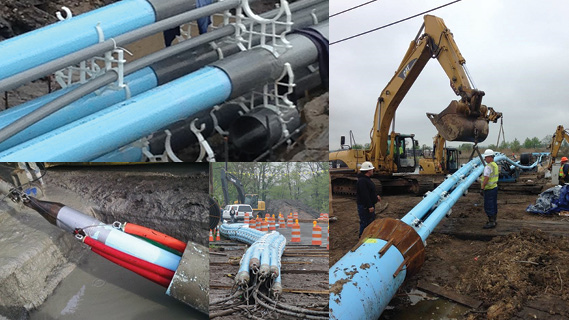How a Directional Drilling Company Overcomes Challenging Geological Conditions?
In the world of underground construction, a directional drilling company’s ability to navigate through challenging geological conditions is nothing short of remarkable. The art of drilling horizontally or at some specific angles has transformed the construction industry, allowing projects to be completed efficiently and effectively, even in the face of formidable obstacles. From rocky terrains to unstable soils and intricate subsurface structures, directional drilling companies have honed their expertise to overcome these challenges and deliver outstanding results.
Today, in this blog post, we delve into the innovative techniques and strategies employed by directional drilling companies to conquer difficult geological conditions. By harnessing cutting-edge technology, employing highly skilled professionals and implementing meticulous planning, these companies have become pioneers in underground infrastructure development.
Overcoming Rocky Terrains:
One of the most common challenges encountered by directional drilling companies is drilling through rocky terrains. Rocky formations can present significant obstacles, as traditional drilling methods often struggle to penetrate solid rock efficiently. However, directional drilling has revolutionized the industry by offering innovative solutions to overcome this challenge.
By utilizing specialized drill bits and advanced drilling fluids, the directional drilling company can effectively bore through hard rock formations, maintaining precise control over the drilling path. One key element is the use of robust drill bits specifically designed to handle the hardness and density of rock formations. These drill bits are well-equipped with strong and durable cutting structures that can effectively break through the rock.
Additionally, drilling fluids play a crucial role in overcoming rocky terrains. These drilling fluids, often referred to as muds, are engineered to possess exceptional suspension and carrying capacities, allowing them to transport the cuttings away from the drilling area. The muds also act as lubricants, reducing friction and heat generated during the drilling process. By maintaining optimal mud properties, directional drilling companies ensure efficient drilling through rock formations.
Real-time monitoring is another vital aspect of overcoming rocky terrains. Direction drilling companies utilize advanced sensors and data analysis systems to constantly monitor the drilling process. This enables them to detect any potential issues or deviations and make immediate adjustments to the drilling path. So, by closely monitoring the drilling operation, they can mitigate the risk of equipment damage and optimize drilling performance.
Tackling Unstable Soils:
Unstable soils pose a significant challenge for directional drilling companies during underground construction projects. These soils can include loose or sandy materials, clay or other unstable formations that make drilling difficult and increase the risk of collapse. To overcome this challenge, directional drilling companies employ various techniques and strategies.
Thorough soil analysis is a crucial step in tackling unstable soils. By conducting detailed assessments of the soil composition and stability, drilling companies can identify potential instabilities and determine the most suitable drilling methods. This allows them to develop tailored solutions to address the specific soil conditions encountered.
Stabilizing additives are often employed to enhance the stability of the soil. These additives can include cementitious materials or chemical agents that strengthen the soil, providing better support for the drilling process. It also helps the directional drilling companies to prevent the risks associated with unstable soils and ensure safer and more efficient operations.
Additionally, advanced steering systems play a key role in tackling unstable soils. These systems allow real-time monitoring and adjustments of the drilling path, ensuring that the drilling operation stays on track even in the presence of unpredictable soil conditions.
So, by constantly adapting to the changing soil properties, directional drilling companies can navigate through unstable soils with greater precision and minimize the potential risks of instabilities or collapses.
Navigating Complex Subsurface Structures:
Directional drilling companies excel at navigating complex subsurface structures, including existing utility lines, natural formations, or densely populated areas. To accomplish this, they employ advanced surveying techniques and cutting-edge 3D imaging technologies.
Thorough surveying and mapping of the underground environment are essential for understanding the complex subsurface structures. So, by conducting surveys and utilizing ground-penetrating radar or LiDAR Technology, directional drilling companies create accurate maps that depict existing structures and potential obstacles. These comprehensive maps allow the companies to meticulously plan the drilling path, avoiding critical subsurface structures while optimizing the efficiency of the drilling operation. Therefore, to minimize the disruptions and ensures the integrity of existing infrastructure, they carefully analyse the data and consider different factors like soil conditions, underground utilities and more.
Conclusion
In the realm of underground construction, a directional drilling company’s ability to overcome challenging geological conditions is a testament to human ingenuity and technological advancements. They have revolutionized the construction industry by employing innovative technologies, cutting-edge machinery and equipment and highly skilled and experienced professionals.
From conquering rocky terrains to tackling unstable soils and navigating the complicated subsurface structures, directional drilling companies offer a reliable solution that saves time, minimize disruptions and ensure the successful completion of the underground construction projects.
As technology continues to advance, we can expect directional drilling companies to push boundaries further, opening up new possibilities in underground infrastructure development.
.jpg)
.jpg)

.jpg)


Comments
Post a Comment